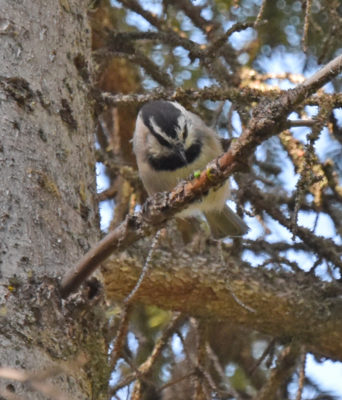While staying in Banff in mid-August, I spent two early mornings wandering happily around the Fenlands Trail adjacent to the Banff town site. The trail was busy with parents pushing strollers, quick walkers out for exercise, dog lovers, and tourists like me. Some of the adjacent streams were alive with rented canoes, kayaks and stand-up paddleboards navigating through the very shallow water. Despite all of this human traffic, I did see and hear quite a few birds. Much to my pleased surprise, I found all three types of Canadian Chickadees during my walks around the Fenlands Trail in Banff.
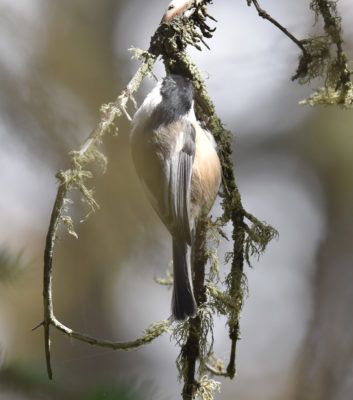
This Black-capped Chickadee is about to pull a caterpillar out of its hiding place.
How Easy Is It to Notice the Different Types of Chickadees?
All of the Chickadees I saw along the Fenlands trail behaved in a similar (and typical!) Chickadee fashion. They flew quickly from twig to branch, sometimes perching upright, other times hanging upside down or even briefly hovering while tugging free food.
All of the groups made contact calls and other sounds. While I didn’t find the calls similar between the different groups, I would not have felt confident identifying a Boreal or Mountain Chickadee solely by its call. Too often, they were only using one-note quick calls which I’m not very familiar with. Even the Black-capped chickadees rarely burst out into their long chick-a-dee-dee-dee-dee-dee song.
Where to See Boreal Chickadees in Banff in the Rockies
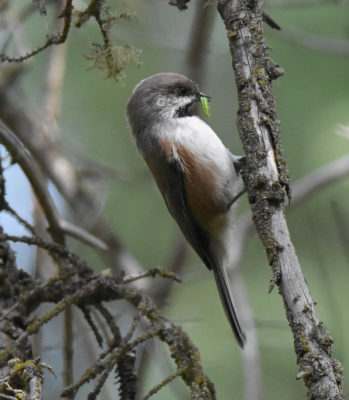
This Boreal Chickadee found several green caterpillars while I watched.
Boreal Chickadees live throughout Canada including in Ontario. I hope to see one here one day if I travel to Algonquin Park or have more time when visiting friends and relatives up north. They like the spruces of the Boreal forest from sea to sea.
As you can see, Boreal Chickadees have a paler, brown head compared to the other Chickadees. But because Chickadees don’t stay still very long and often hunt at odd angles, it took time to get a clear look at the heads to be sure what type of bird I was looking at.
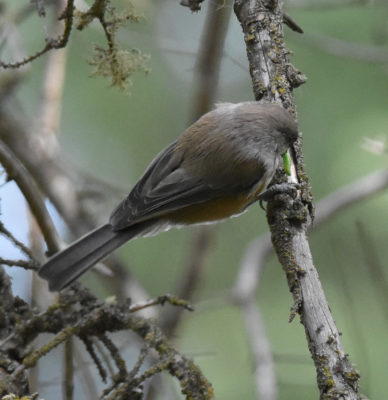
The paler head should have told me this was a Boreal Chickadee even from this view, but I wasn’t sure till I saw its face.
The only place I saw Boreal Chickadees for sure in Banff National Park in the Rockies was along the Fenlands Trail. I think I may have seen one on another trail but I have to search through a lot more photos to see if I can prove it.
Where to See Mountain Chickadees in Banff, Alberta
While I can see Boreal Chickadees in Ontario if I travel far enough north, I can’t see Mountain Chickadees here. These tiny birds want to live in *real* mountains (well, young mountains anyway) and in Canada are found only in Alberta, BC and the Yukon. Apparently the Appalachians don’t impress them much!
So I was quite pleased to have one (and only one) close encounter with Mountain Chickadees while visiting Banff.
These were the only Chickadees that I could safely identify quickly in the field. The white “eyebrow” or supercilium is quite noticeable even from a distance: *if* you can get a look at their faces. It did take some frantic tracking with the camera lens (I wasn’t using binoculars) to obtain a clear look at one’s face.
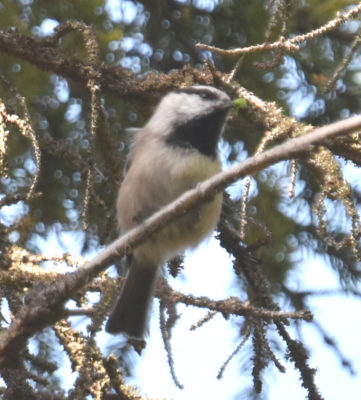
From below, I had to wait till this Chickadee tiled its head a bit to make sure it had the white line field mark for a Mountain Chickadee.
The Mountain Chickadees I watched were in a group, possibly a family, of three, moving quickly through the Spruce trees on the Fenlands Trail.
Where to See Black-capped Chickadees in Banff National Park
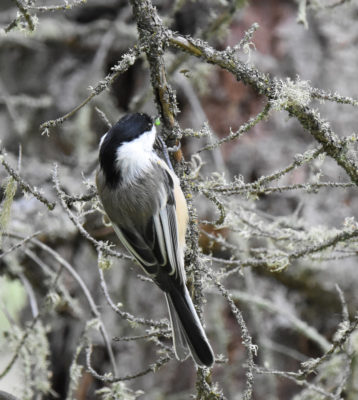
This Black-capped Chickadee has found another green caterpillar.
We saw Black-capped Chickadees several places in Banff National Park. Like elsewhere in southern Canada, they are the most common Chickadee. There was a family of Black-capped’s in the trees outside our hotel at the foot of Mount Norquay. And I met a large flock of at least 5 birds (probably also a family) busily hunting along the Fenland Trail in the spruces.
Again, I had to check the faces of the birds carefully before I was sure they were Black-capped Chickadees. With two other types busily hunting in the same forest, it wasn’t an automatic id!
What Are All of These Chickadees Eating in the Spruce and Fir Trees?
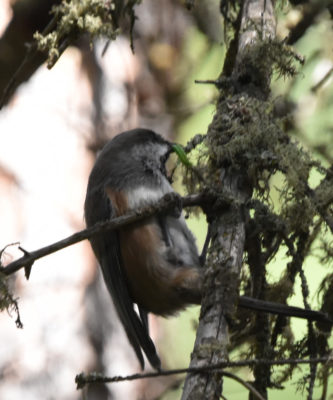
This Boreal Chickadee curled a bit to get at this caterpillar.
One thing I noticed in my photos that I couldn’t see clearly when I was outside in the woods was that all of the types of chickadees were eating the same bright green caterpillars. The caterpillars are small and have two faint white or cream lines on the side.
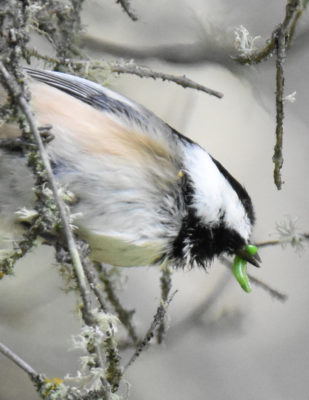
You can see that these caterpillars can make a good sized snack for a Black-capped Chickadee.
Interestingly, the birds often seemed to find them on what looked like dead branches. The caterpillars may have been hidden in the lichens some of which look like Spanish Moss, or they may have been under the bark.
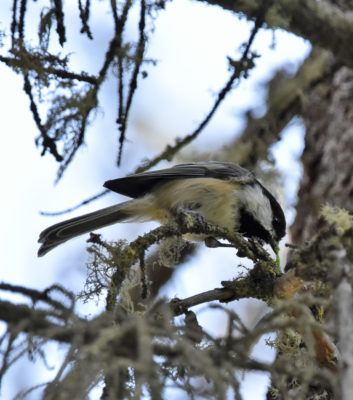
This caterpillar is stretching so it might be holding on to the twig.
I’m not sure what kind of caterpillars they are. The colouring seems wrong for Spruce Budworm. The Fenlands trail is mostly surrounded by Spruce trees, though. If anyone knows, please be sure to share the info in a comment.
I’ve seen Chickadees in Ontario banging caterpillars against branches before eating them. I noticed these Chickadees in Banff did the same thing. I don’t know if it’s to stun or kill the caterpillar, to remove spines or other unpleasant parts, or to tenderize them.
I was very pleased to get to see all three types of Chickadees so close to where we were staying and along such an easy path. I hope other visitors to Banff have the same success!
Related Reading
- Hiking with Barry: Fenland Trail, Banff National Park
- Chickadees Shelter the Winter Storms in Mississauga Crabapple Tree…
- Chickadees Excavating and Woodpeckers Chiseling Nests and Other Sights of Spring at the Rattray Marsh
Join In
Which type of Chickadees brightens up your back yard? Please share your sighting with a comment.

